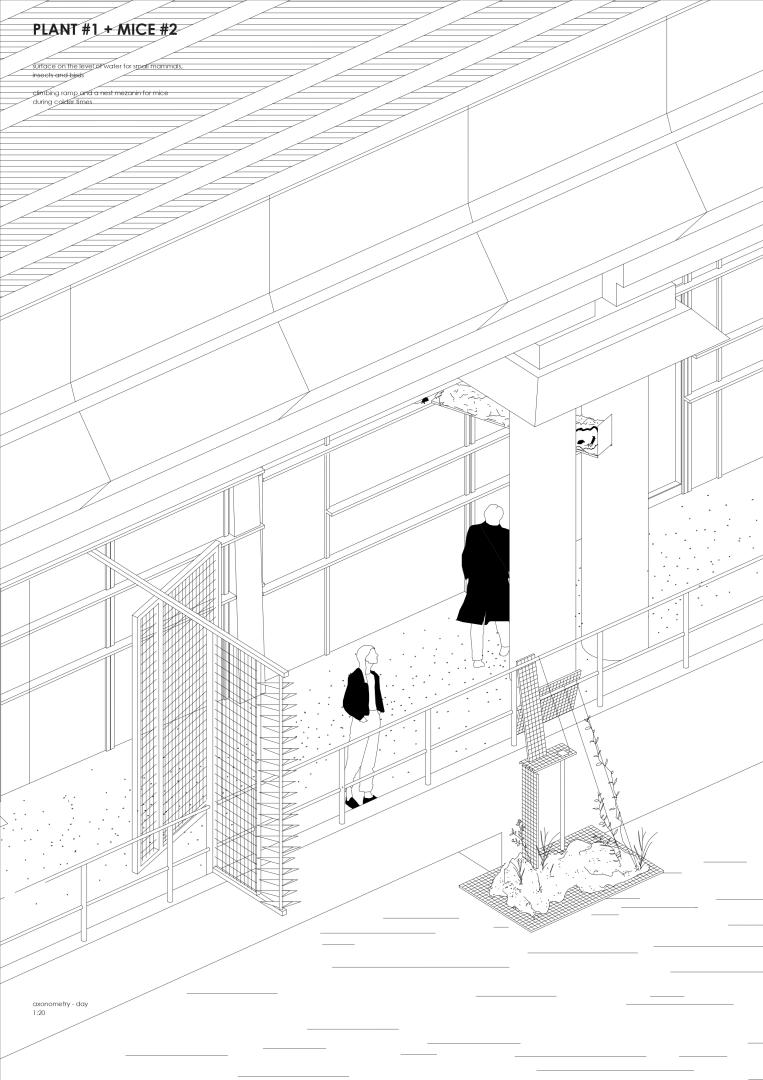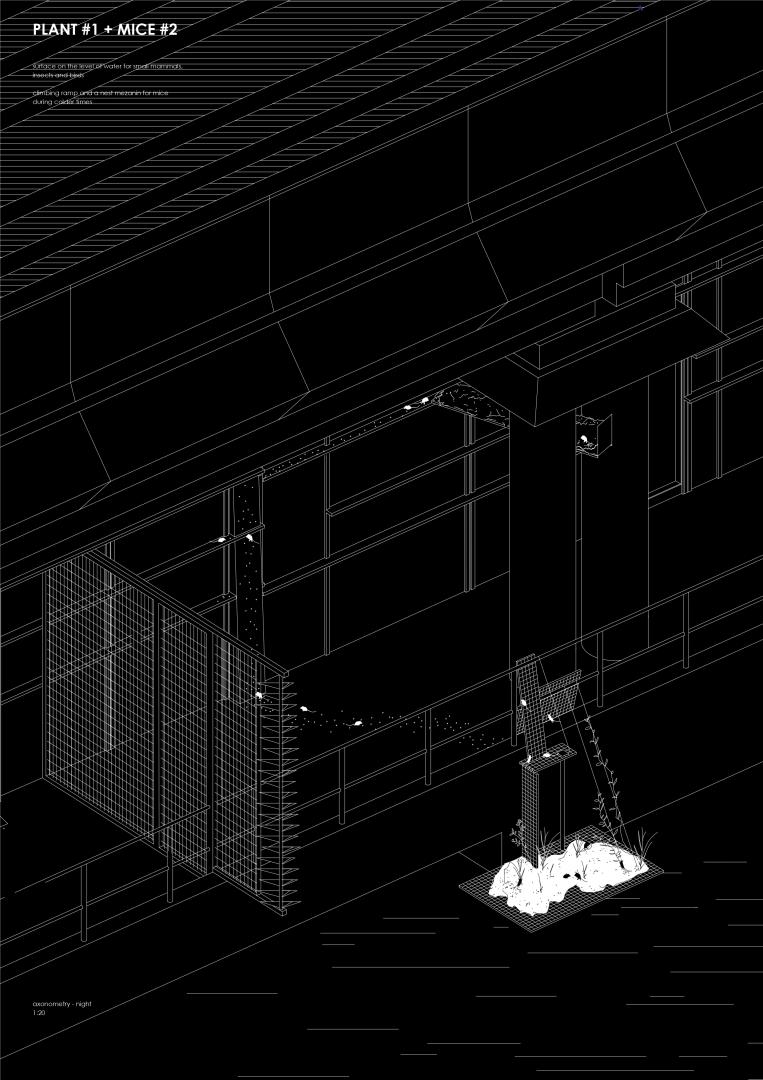Multispecies City
Basic information
Project Title
Multispecies City
Category
Reconnecting with nature
Project Description
How can we design an inclusive space within a city for all living beings?
As a ´non-humancentric´ design approach towards the urban environment, alterations like add-ons of left out spaces in/on/around infrastructures within a city to adapt the environment towards a multispecies society. These add-ons are the first steps of a society and design not yet existing.
As a ´non-humancentric´ design approach towards the urban environment, alterations like add-ons of left out spaces in/on/around infrastructures within a city to adapt the environment towards a multispecies society. These add-ons are the first steps of a society and design not yet existing.
Geographical Scope
Local
Project Region
The city of Amsterdam, Netherlands
Urban or rural issues
Mainly urban
Physical or other transformations
It refers to a physical transformation of the built environment (hard investment)
EU Programme or fund
No
Description of the project
Summary
There is a growing need of space for other than human species. The natural environments and habitats are altered by industries so drastically, the amount of species who are forced to migrate to urban environments and adapt their habitats are increasing.
The idea is to take advantage of left out spaces, materials, gadgetries around the city (in this scenario an area within the city of Amsterdam) and repurpose them to create modifications for `other than human species´. These spaces can be referred to as some sort of infrastructure such as rail tracks, electricity boxes, construction poles, metro ventilation, or even later-added small structures onto buildings by humans, such as ramps for entrances, draining pipes, cladding, metal ropes for plants...
The characteristic of these examples is the un-usability or better said that these spaces are only there for the usage of machines, natural/man-made current, circulation, and temporary structures that won´t/cannot be used by neither human nor other species as proper spaces at the moment.
By acknowledging the existence and the potential of these spaces, a transformation of the currently know urban environment is intended.
THEY ARE THE FIRST STEPS OF A MULTISPECIES SOCIETY NOT YET EXISTING.
The idea is to take advantage of left out spaces, materials, gadgetries around the city (in this scenario an area within the city of Amsterdam) and repurpose them to create modifications for `other than human species´. These spaces can be referred to as some sort of infrastructure such as rail tracks, electricity boxes, construction poles, metro ventilation, or even later-added small structures onto buildings by humans, such as ramps for entrances, draining pipes, cladding, metal ropes for plants...
The characteristic of these examples is the un-usability or better said that these spaces are only there for the usage of machines, natural/man-made current, circulation, and temporary structures that won´t/cannot be used by neither human nor other species as proper spaces at the moment.
By acknowledging the existence and the potential of these spaces, a transformation of the currently know urban environment is intended.
THEY ARE THE FIRST STEPS OF A MULTISPECIES SOCIETY NOT YET EXISTING.
Key objectives for sustainability
Existing spaces within the city are altered rather than rebuilt/remade. As main structural elements, reusable construction site materials such as scaffolding, metal mesh, street poles and sheets are selected. These materials are collected from the storage facilities of the street building department of the municipality. Later on, these structures are filled with natural or found materials such as dirt, paper, hay, etc.
The selected materials for the structures can easily be mounted, taken off and adjusted on to the existing infrastructural spaces and repurposed. The adjustability of these add-ons are key, due to the explorative approach towards multispecies likings and their needs. The usage of the additional found and natural materials is chosen and partially left out according to the specific species for whom they are built. These make the spaces inhabitable and flexible for the species they attract.
The created spaces are just tools to open up possibilities of co-existence to create multispecies environments with a non-humancentric design that provides continuous transformation.
The selected materials for the structures can easily be mounted, taken off and adjusted on to the existing infrastructural spaces and repurposed. The adjustability of these add-ons are key, due to the explorative approach towards multispecies likings and their needs. The usage of the additional found and natural materials is chosen and partially left out according to the specific species for whom they are built. These make the spaces inhabitable and flexible for the species they attract.
The created spaces are just tools to open up possibilities of co-existence to create multispecies environments with a non-humancentric design that provides continuous transformation.
Key objectives for aesthetics and quality
Reusable construction site materials fit the infrastructural spaces. The aesthetics of the spaces are kept at first but are unknown how they will evolve a sense of aesthetics with usage by multispecies, including humans.
This results in varying looks, sizes and aesthetics from location to location and according to specific needs of included species, and available space and material. Local-specific possibilities of lost spaces give way to explorative design. Taking advantage of and bringing out the beauty of how adaptable these lost spaces are, can allow long-lasting transformations of our built urban environment.
This results in varying looks, sizes and aesthetics from location to location and according to specific needs of included species, and available space and material. Local-specific possibilities of lost spaces give way to explorative design. Taking advantage of and bringing out the beauty of how adaptable these lost spaces are, can allow long-lasting transformations of our built urban environment.
Key objectives for inclusion
This project aims to establish a new societal model, where a multispecies society is built as a neighborhood ecosystem in an urban environment. The inclusion of other than human species to the society and building processes are footsteps of thinking inclusivity beyond humans, reconnecting with nature as well as altering the definitions of natural and urban environment beyond their territories.
How Citizens benefit
After receiving great enthusiasm by colleagues and fellows, it is planned to take further steps in realizing the project and of its approach. According to the outcomes and the process, proper planning for the applicability of the project for different locations and participants can be established.
For the first step, a group is created by interested students. This group will be expanded and participants from different backgrounds as well as citizens will be included. The proper steps as well as establishment of particular beneficiaries need to be yet determined.
For the first step, a group is created by interested students. This group will be expanded and participants from different backgrounds as well as citizens will be included. The proper steps as well as establishment of particular beneficiaries need to be yet determined.
Physical or other transformations
It refers to a physical transformation of the built environment (hard investment)
Innovative character
Inclusion on a multispecies level opens up new relationships and co-habitable spaces within existing environments. Humans will no longer be considered separate from these systems. It shows not only that cities are not necessarily unimaginable/unusable/unhabitable environments for other species but also that we do not solely have to expand/redo/rebuild/demolish… our environment.
It rather takes the principle of simple acts, acts we as humans already conduct on our own to better the conditions of our own spaces, the very act of practicality within design. This shift of our behavior indicates the possibilities beyond our imagination to produce progressive multispecies cultures.
It rather takes the principle of simple acts, acts we as humans already conduct on our own to better the conditions of our own spaces, the very act of practicality within design. This shift of our behavior indicates the possibilities beyond our imagination to produce progressive multispecies cultures.
Disciplines/knowledge reflected
“Non-humancentric design” and its justification has been a controversial topic. The needs and more so the likings of other species are fairly unknown to the humankind. Only through observation and scientific discovery, can we try to understand and confirm our humanly constructed knowledge on ways of living of other species. Designing spaces for other than human beings might be even considered humancentric, when design is imposed onto the species rather than explored with them. How can we design an inclusive space for all living beings?
Does it not indicate that this cannot be narrowed down to specific disciplines?
Does it not indicate that this cannot be narrowed down to specific disciplines?
How stakeholders are engaged
The starting point of the project focuses on the individuals within the social context, neighborhoods. Although this approach as a mindset can be implemented on a larger scale by cities, regional planners and grow even further, its practice is intended to keep its intimacy between the individuals from different species that are connected within their spaces.
Key is to continue acknowledging the simplicity of the approach and its nature of being small scale. These interventions should not be brought to the human scale, or better said beyond the human scale.
Key is to continue acknowledging the simplicity of the approach and its nature of being small scale. These interventions should not be brought to the human scale, or better said beyond the human scale.
Global challenges
Although the interventions can be considered very site specific, the outcomes of these alterations have the potential to impact beyond regions. Considering migration routes, ecological chains, natural habitats, these inhabitable interventions will allow co-existence and togetherness, and create a network.
Local processes become the backbone of a masterplan for future environments.
Local processes become the backbone of a masterplan for future environments.
Learning transferred to other parties
The project can be implemented by individuals within any social context, such as neighborhoods with no specification. Lost spaces can be found wherever humans have altered their surroundings to benefit one way or another.
The simplicity and playfulness of the structures allow individuals, neighborhoods, and communities to take part in the building process of these add-ons. The process can be easily conducted through simple assembly manuals along with a list of materials needed.
The methodology of the project can be practiced in educational institution or municipalities of different areas, where the design as well as material availabilities and the necessary information such as manuals can produced and formed.
The simplicity and playfulness of the structures allow individuals, neighborhoods, and communities to take part in the building process of these add-ons. The process can be easily conducted through simple assembly manuals along with a list of materials needed.
The methodology of the project can be practiced in educational institution or municipalities of different areas, where the design as well as material availabilities and the necessary information such as manuals can produced and formed.
Keywords
Non-humancentric design
Ecosystems within Neighborhoods
Adaptation of an urban environment
Infrastructure
Reuse/Repurpose


